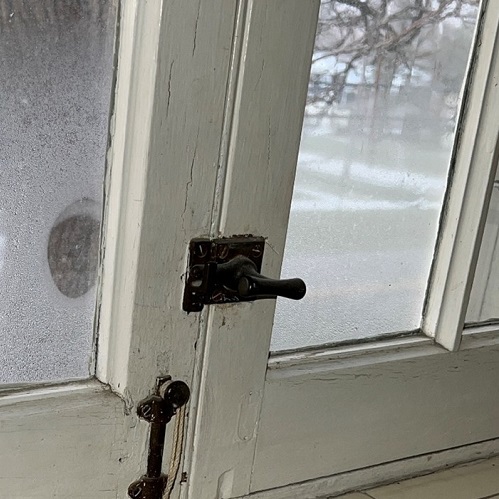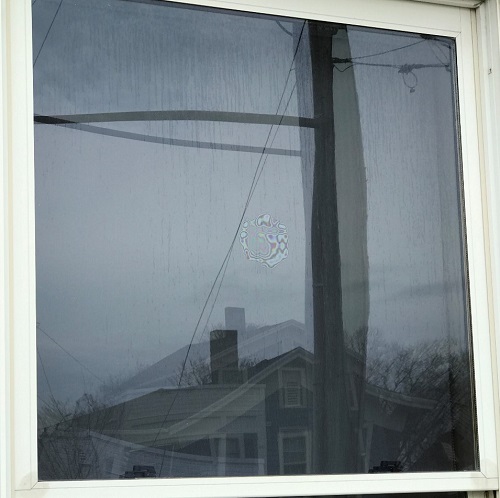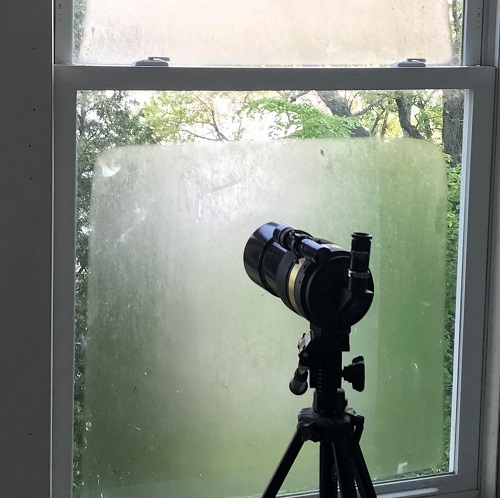Window Condensation Tells Many Tales
An exploration of thermal resistance in insulating glass units
Condensation, whether wanted or not, can be a useful indicator of many physical processes. By observing the condensation trails of high-altitude jet planes, for example, one can easily estimate the speed, direction and stability or turbulence of air in the upper atmosphere. Hugely complex and expensive atomic accelerators use condensation trails in cloud chambers to identify the sub-atomic particles resulting from their tests. And the window industry can easily use condensation to observe many aspects of the performance of our now increasingly complex fenestration constructions.
 An unusual circular clear spot (see photo below) in the condensation on the left side of the inner surface (#2) of the exterior storm window in front of a single clear glass casement window in the upper floor of my 100-year-old house in Ohio prompted investigation.
An unusual circular clear spot (see photo below) in the condensation on the left side of the inner surface (#2) of the exterior storm window in front of a single clear glass casement window in the upper floor of my 100-year-old house in Ohio prompted investigation.
On examination I found the typical “stack effect” of warm air rising in a leaky old house and escaping out the equally leaky old windows. Loose-fitting exterior storm windows are excellent thermal and acoustic insulation when the inside window is tight fitting. In that sealed case, the air in the space between the lights is relatively dry coming from the outside, at least compared to the inside air with added moisture from people. Therefore, condensation is seldom seen.
But in my case, the seal around the window catch is imperfect: a steady laminar flow of moist warm air is pushed past the catch. At first, the warm air hitting the storm window heats it, making a warmer circular spot with no condensation. But when that moving air cools, it adds its moisture to cooler surfaces in the form of visible condensation.
Condensation’s harmful effects
In general, window condensation should not be allowed to happen. Lasting for a short duration it simply—and usually harmlessly—distorts the viewing optics, but if condensed water accumulates, it quickly starts to damage paint work and underlying wood framing. Left in place for a longer duration, that water can readily lead to mold growth. On the atmosphere side of float glass, a thin film of condensation can slowly start to leach out sodium ions, leading ultimately to faintly visible glass corrosion and permanent stain. The other, tin-side, surface of float glass is slower to stain.
Insulating glass double glazing with metal or glass spacers was the first attempt to improve window insulation and was about twice as good, with R-2 insulation in most of the vision area. If the frame was wood and not metal, then the condensation problem was reduced to a visible band near the edge of the glass caused by the thermal conductivity of the IG spacer.
My house had some fused glass edge sealed double glazing. That IG seal was absolutely airtight and was fully compatible with every possible glazing compound. Even when window sash leaks added to the condensation at the R-1 edge from the glass spacer and let the IG unit sit in liquid water, its seal was indestructible. But as can be imagined, condensation rotted the window sashes and, ultimately, they all had to be removed, even though the IG seals were still perfect.
The value of gas-fill
Long ago I saw Scandinavian window designs with deep pockets for double- and triple-glazed IG units. Thus, their conductive metal edge spacers could be buried deep in large dimension wooden frames so the perimeter area and IG edge condensation problems were avoided. But I wonder how often that design experienced cold weather breakage from the clamped edge effect of a deep glazing pocket.
When a sealed air space cools and shrinks, the stress at the glass edge will be up to four times greater if the edges are “clamped” and prevented from the small rotation of typical “simply supported” edges. Such stress is often sufficient to cause breakage in relatively small size IG units.
I replaced the leaky frame single-glazed attic windows in my old house with smart-looking, true divided-light, low-emissivity, argon gas-filled IGs in sliding sashes. All arrived correctly, with low-E as checked by the colored reflection from the coated surface, but, surprisingly, a few of the units were perfectly flat on the coldest days. Those few units also remained flat when they warmed up on sunny days. Suspecting leaking IG units would have allowed the insulating argon to escape, while the active desiccant would still have kept the air space relatively dry for some time, I boiled kettles on a cold day and circulated the resulting humid air until condensation occurred only on the flat, leaking units. This showed the useful insulation value of argon when it is present. The window manufacturer was most obliging in honoring its warranty.
Window performance
 Even with today’s high-performing low-E coatings and very low conduction foam silicone or other IG spacer material giving R-3 thermal resistance and greater, one can occasionally see a unit with an unexpected #4 surface circular patch of winter condensation in the middle of a unit. Further investigation might show that high-speed IG production can inadvertently seal a hot IG unit when the glass has been washed with hot water. As the sealed air space cools to room temperature, it shrinks and, in the extreme case, larger sizes of thinner glass can end up with the glass touching at the center. This results in only R-1 insulation there.
Even with today’s high-performing low-E coatings and very low conduction foam silicone or other IG spacer material giving R-3 thermal resistance and greater, one can occasionally see a unit with an unexpected #4 surface circular patch of winter condensation in the middle of a unit. Further investigation might show that high-speed IG production can inadvertently seal a hot IG unit when the glass has been washed with hot water. As the sealed air space cools to room temperature, it shrinks and, in the extreme case, larger sizes of thinner glass can end up with the glass touching at the center. This results in only R-1 insulation there.
Other factors such as trapped humidity being adsorbed by the desiccant, selective gas diffusion in and out through the sealant, bowed heat treated glass being assembled with the convex surfaces (#2 and #3) toward each other, or altitude differences between sealing and installation locations can add to this center-touching process. While such condensation and the associated Newton Rings are rarely seen today, it is noted that many residential, and some annealed commercial IG units, are all too often observed to be concave at room temperatures when they should be relatively flat.
A new design of IG with a vacuum gap and low-E coatings gives R-5 and more thermal resistance to the central area, which eliminates condensation there. Miniscule pillars between the lights support the glass inboard from the rigid ceramic glass seal at the edge of the vacuum IG unit so no breakage stress occurs at the resulting clamped edges. But, as before, the thermal resistance at the very edge reverts to R-1 and that edge needs to be buried deep in an insulating frame to avoid perimeter condensation.
 An irony of the condensation story is that it sometimes now tells us when our window performance is almost too good. A gas-filled, double- or triple-glazed, low-E coated IG unit insulates so well that on a still-air, cold winter night, with direct line of sight to a clear sky, surface #1 of the unit radiates more heat outward than it receives inward from the sky. With little or no heat coming from the warm house interior because of the super-efficient insulating glass layers, gas fill and low-E coatings, the #1 surface temperature can fall a few degrees below that of the outside air. If the outside air is humid, the glass temperature can fall below the dew point and temporary condensation harmlessly forms on surface #1, thus demonstrating the amazing improvements available in current window design.
An irony of the condensation story is that it sometimes now tells us when our window performance is almost too good. A gas-filled, double- or triple-glazed, low-E coated IG unit insulates so well that on a still-air, cold winter night, with direct line of sight to a clear sky, surface #1 of the unit radiates more heat outward than it receives inward from the sky. With little or no heat coming from the warm house interior because of the super-efficient insulating glass layers, gas fill and low-E coatings, the #1 surface temperature can fall a few degrees below that of the outside air. If the outside air is humid, the glass temperature can fall below the dew point and temporary condensation harmlessly forms on surface #1, thus demonstrating the amazing improvements available in current window design.



